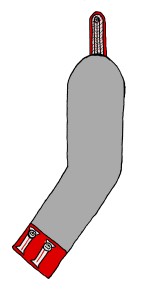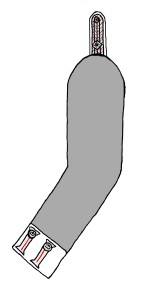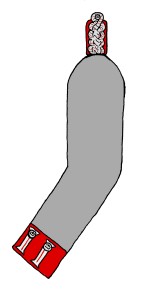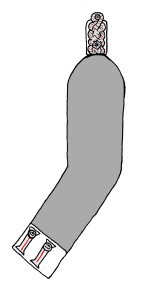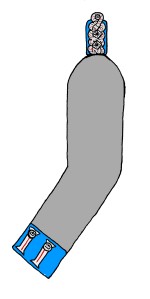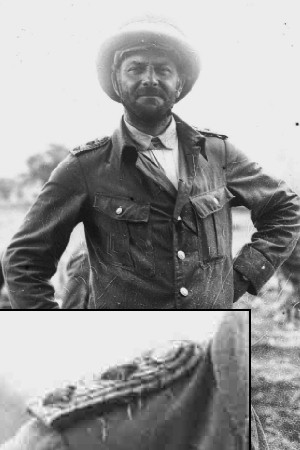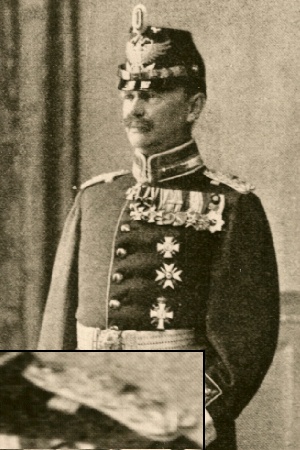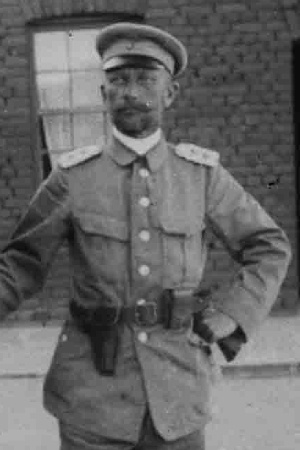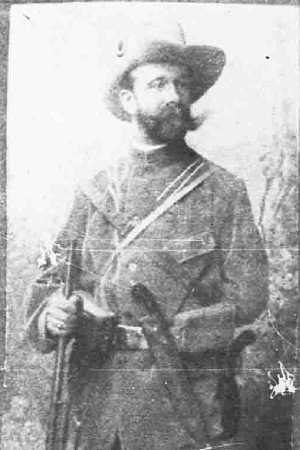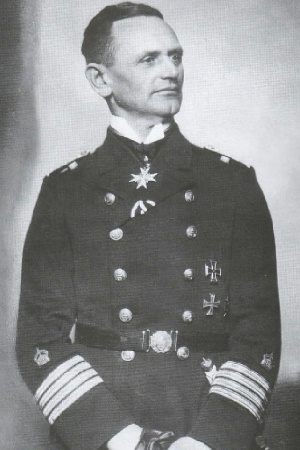|
As shown above, Junior Officers wore shoulder straps made of white metallic lace cords with black and red
threads on a colony coloured backing. Having no pips, one pip or two
showed the grade of junior officer.
Senior Officers wore shoulder straps
made of twisted white metallic braid on a backing of the colony
colour. Again having no pips, one pip or two showed the grade of senior officer.
The colony colours of red for Cameroon, white for East Africa and blue
for South West Africa are shown on these examples.
|
A Comparative Table of
Schutztruppe and British Army Officer's Ranks
Junior Officers |
| Leutnant |
- |
Second Lieutenant |
| Oberleutnant |
- |
Lieutenant |
| Hauptmann |
- |
Captain |
|
Senior Officers |
| Major |
- |
Major |
| Oberstleutnant |
- |
Lieutenant Colonel |
| Oberst |
- |
Colonel |
|
General Officers |
| Generalmajor |
- |
Brigadier General |
| Generalleutnant |
- |
Major General |
| General der
Schutztruppe |
- |
Lieutenant General |
| Generaloberst |
- |
General |
| Generalfeldmarschal |
- |
Field Marshall |
Notes on German Officers Ranking System
Errors in Rank Translation
As can be seen from the above table several
ranks that sound similar in German and English do not exactly equate (eg. Leutnant/Lieutenant
and Generalmajor/Major General). This has caused errors in translation in
several English language sources (probably occasionally repeated on this website).
This is one reason I prefer to stick to German rank titles on
this website
Generals and the Highest Ranking
Officers
The subject of General Officers
and their rank insignia is covered on the
Schutztruppe Generals Page although for the study of the
German Colonies it is largely academic as very few officers of
General rank ever served there. At the outbreak of the First
World War the highest ranking active military officers in each colony were-
Oberstleutnant
von Heydebrerck (South West Africa)
Oberstleutnant von
Lettow-Vorbeck (East Africa)
Major Zimmerman (Cameroon)
Major von Kessinger (of the III. Seebataillon at Tsingtao)
Hauptmann Georg Pfähler
(Togo)
Rittmeister von Klewitz (New Guinea)
Samoa had no active military officers
Pre-1899 Lieutenant Titles
Prior to 1st January 1899, the rank of
Leutnant was called "Sekonde-Lieutenant", while Oberleutnant was
known as "Premier-Lieutenant" in the Imperial army and also
the Schutztruppe (see
Axis History Forum).
The Wissmantruppe had never made a difference between grades of
Leutnant.
Rittmeister Cavalry Captain Title
The rank of Hauptmann was called a "Rittmeister"
in cavalry units. While this did not apply to the Schutztruppe in
Africa where no true cavalry units existed, it did apply to the East
Asian cavalry in China and to the Asienkorps cavalry in Palestine. Also
army officers were sometimes seconded to the colonies, keeping their
original rank title, for example the commander of the German forces in New Guinea in the First World War,
Carl von Klewitz, was a cavalry captain and bore the title Rittmeister von
Klewitz.
Marine Infantry Insignia
Officer shoulder straps for the
Seebataillon were similar to those of the Schutztruppe but had a yellow
metal Imperial crown on the shoulder
strap above any pips.
Overseas Imperial Army Officers Rank Insignia
The same system of shoulder straps with pips was used by the
Schutztruppe was used by units of the Imperial army overseas including
the East Asian Expeditionary Corps, Pascha Expeditions in the Ottoman
Empire and army officers seconded overseas and to the colonies. The differences being
that the army had state coloured threads in their shoulder straps
(Prussia- black and white, Bavaria- blue and white, Saxony- green and
white etc) and that they wore a yellow or white metal numeral or
monogram of their unit above any pips.
First World War Variations
During the First World War white metallic
lace shoulder straps were replaced in army (and naval) units with dull
grey lace. This of course did not apply to officers in the colonies who
were cut off from Germany throughout the war. Privately Purchased Uniforms
Officers almost always had privately
purchased uniforms. These were made by tailors in Germany following the
regulations issued by the Colonial Office. This meant that they were
usually of better quality than other ranks uniforms but also that they
often varied slightly in cut and manufacture. The same principles were
applied to footwear and weaponry.
Other Officers Uniform Distinctions
Officers were distinguished by
having metallic insignia such as collar ands cuff Litzen while other
ranks had plain white or yellow cloth. Small details such as more
elaborate cockades and silver cords around the tropical helmet
distinguished them though most uniforms were essentially the same cut as
for other ranks.
Officers Weapons and Equipment
Officers carried swords with sword
knots on parade with silk belts. On campaign they usually had pistols
and Sam Brown belts. These were sometimes replaced with other ranks
rifles so as not to make the officers so easy for enemy snipers to spot.
|
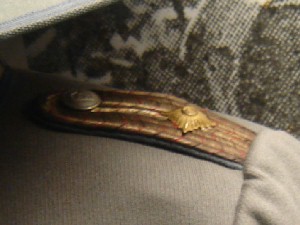
Schutztruppe
Oberleutnant Shoulder Strap
Shown on a Schutztruppe 1897 officers grey home tunic. Note the single pip of an Oberleutnant on the white metallic lace
shoulder strap with threads of red and black with blue (for South West Africa) as the underlay.
Photo by C Dale at the
Bavarian Army Museum
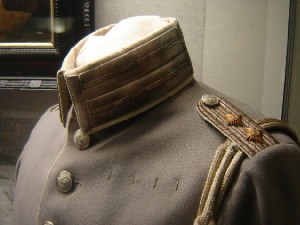
East African Schutztruppe
Hauptmann
Shown on a Schutztruppe 1897
officers grey home tunic. Note the two pips of a Hauptmann on the white metallic lace shoulder strap
with threads of red and black with white (for East Africa) as the underlay.
Photo by C Dale at the
Bavarian Army Museum

Marine Infantry Leutnant Shoulder Strap
Shown
on a Marine Infantry Officers white tropical tunic. Note lack of pips of a
Leutnant but the Imperial Crown of the Marine Infantry on the white metallic lace shoulder strap
with threads of red and black with white (for Marine Infantry) as the underlay.
(see
Seebataillon Officers White
Uniform Page)
Damien Doppler Collection
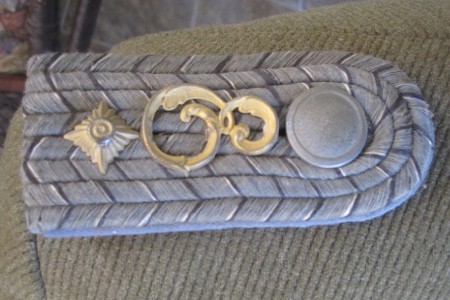
Prussian Railway
Oberleutnant Shoulder Strap
Shown on the corduroy tunic of a Prussian officer,
Oberleutnant Kloevekorn who worked on the Baghdad
Railway during the First World War. Note the
single pip of an Oberleutnant, the stylised E (for
railway- "Eisenbahn") as a unit badge, the Prussian black and white threads in the
grey wartime shoulder strap with the blue underlay
of a railway officer.
(See
Baghdad Railway Officers Uniform Page)
Photo © A Private US Collector |
